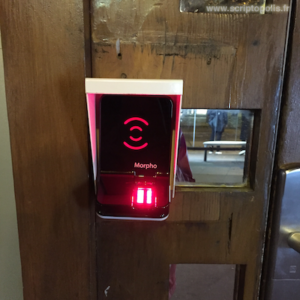Who’ s there?
It begins like in a fairy tale: knock, knock, knock, “- Who’ s there?”. But, in front of this wooden door, which could be the grandmother’s in the Tales of Mother Goose, there is no need to announce yourself (” – It’s Little Red Riding Hood “), to get the sesame (” – Pull the bobbin, and the latch will go up “). The door doesn’t need a name to investigate the reality of physical presence; 21st-century grandmothers have installed biometric scanners to authenticate at a distance the alleged grandchild. They distinguish little girls from the big bad wolves thanks to personalized traces, the imprints, those signs that the folding of cellular layers has sculpted on our fingers as early as the 24th week of foetal life.
Animals and humans have been decoding prints as signs of identity for hundreds of thousands of years, but the distinctive virtue of fingerprints did not become state knowledge until the end of the 19th century, as the need for population surveillance grew and the fingerprinting method expanded. The registration of fingerprints, classified as ‘sensitive data’ by GDPR, is now commonplace. In addition to profiles on social networks or behavioural data on the web, fingerprints are part of our digital identities. They are disseminated in a variety of databases: on our smart phones, in our employers’ databases, and also in government files.
The installation of such biometric scanners, here visible from the public space, but most often hidden by the convenience of a technological arrangement, presupposes for the past and the future the existence of a database in which the biometric profiles of authorized persons are stored. It also assumes, here and now, that here and now, little girls and wolves submit to the binding rite that perpetuates the validity of access. At this point, the moral structure of the fairytale may branch off and open the way to other, why not more adventurous, tales.







